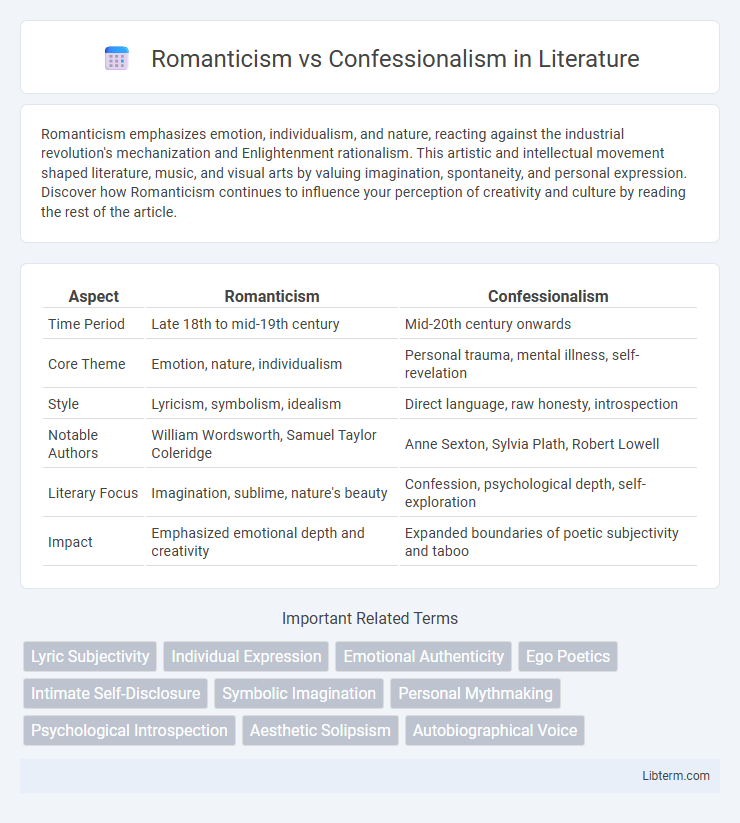Romanticism emphasizes emotion, individualism, and nature, reacting against the industrial revolution's mechanization and Enlightenment rationalism. This artistic and intellectual movement shaped literature, music, and visual arts by valuing imagination, spontaneity, and personal expression. Discover how Romanticism continues to influence your perception of creativity and culture by reading the rest of the article.
Table of Comparison
| Aspect | Romanticism | Confessionalism |
|---|---|---|
| Time Period | Late 18th to mid-19th century | Mid-20th century onwards |
| Core Theme | Emotion, nature, individualism | Personal trauma, mental illness, self-revelation |
| Style | Lyricism, symbolism, idealism | Direct language, raw honesty, introspection |
| Notable Authors | William Wordsworth, Samuel Taylor Coleridge | Anne Sexton, Sylvia Plath, Robert Lowell |
| Literary Focus | Imagination, sublime, nature's beauty | Confession, psychological depth, self-exploration |
| Impact | Emphasized emotional depth and creativity | Expanded boundaries of poetic subjectivity and taboo |
Understanding Romanticism: Core Themes and Characteristics
Romanticism emphasizes intense emotion, individualism, and a deep connection to nature, often highlighting imagination and the sublime as core themes. Its characteristics include an emphasis on heroic figures, idealization of the past, and exploration of the supernatural or mystical experiences. This movement values personal expression and emotional depth, contrasting with later literary styles focused on introspection and psychological realism.
The Emergence of Confessionalism in Literature
The emergence of Confessionalism in literature marked a distinct shift from the emotional idealism of Romanticism toward raw, personal expression and psychological introspection. Confessional literature foregrounds intimate, often taboo subject matter, reflecting authors' inner turmoil and private experiences with unprecedented candor. This movement redefined narrative voice and thematic exploration, prioritizing authenticity and vulnerability over Romantic idealization.
Historical Contexts: Romanticism vs Confessionalism
Romanticism emerged in the late 18th century as a reaction against the Enlightenment, emphasizing emotion, individualism, and nature during periods of political upheaval like the French Revolution. Confessionalism gained prominence in the 20th century, particularly post-World War II, highlighting personal, often autobiographical, expressions of faith and identity amid social and existential crises. The historical contexts of these movements reflect Romanticism's response to rationalism and industrialization, while Confessionalism addresses modern alienation and the search for authenticity.
Key Figures in Romanticism and Confessionalism
Key figures in Romanticism include William Wordsworth, Samuel Taylor Coleridge, and Lord Byron, whose works emphasize emotion, nature, and individualism. Confessionalism, exemplified by poets like Sylvia Plath, Anne Sexton, and Robert Lowell, delves into personal trauma, mental health, and intimate experiences through candid, self-revealing poetry. These movements differ significantly in style and focus, with Romanticism highlighting external inspiration and Confessionalism prioritizing internal exploration.
Exploring Subjectivity: Personal Emotion in Both Movements
Romanticism emphasizes the celebration of individual emotion and the sublime experiences of nature, highlighting intense personal feelings as a source of artistic inspiration and truth. Confessionalism delves deeper into the raw, often painful personal experiences, revealing inner psychological conflicts and intimate self-examination with unfiltered honesty. Both movements prioritize subjectivity but contrast in their approach: Romanticism idealizes emotion, while Confessionalism exposes vulnerability through candid self-expression.
Stylistic Differences Between Romantic and Confessional Writing
Romantic writing emphasizes emotional intensity, vivid imagery, and the celebration of nature, often featuring elaborate metaphors and idealized language to evoke a sense of wonder or sublime experience. Confessional writing, in contrast, is characterized by stark realism, introspective honesty, and a raw, unfiltered tone that foregrounds personal trauma and psychological complexity without embellishment. While Romanticism employs symbolic and often ornate stylistic devices to express universal themes, Confessionalism adopts a candid, straightforward style that prioritizes individual experience and emotional vulnerability.
Nature and the Self: Divergent Perspectives
Romanticism idealizes nature as a profound, spiritual force reflecting the sublime essence of the self, emphasizing emotional intuition and the individual's harmony with the natural world. Confessionalism prioritizes introspective self-examination, presenting nature more as a backdrop for personal vulnerability and the raw revelation of inner psychological states. These divergent perspectives highlight Romanticism's collective, transcendent vision versus Confessionalism's intimate, often fragmented exploration of identity.
Influence of Romanticism on Confessional Poets
Romanticism profoundly influenced confessional poets by emphasizing individual emotion, imagination, and the exploration of the self, leading to deeply personal and introspective poetry. Romantic ideals of nature, emotion, and the sublime provided a framework for confessional poets to express mental anguish, trauma, and intimate experiences candidly. The emphasis on authenticity and subjective truth in Romantic literature directly shaped the thematic intensity and stylistic features of confessional poetry.
Critical Reception: Then and Now
Romanticism initially faced criticism for its emphasis on emotional excess and idealism, often dismissed as overly sentimental by 19th-century critics who valued rationalism. In contrast, Confessionalism, emerging in the mid-20th century, was praised for its raw, personal honesty and introspective depth, marking a shift toward valuing individual experience in literature. Contemporary scholars recognize Romanticism's influence on modern literary aesthetics while appreciating Confessionalism's contribution to the authenticity and vulnerability in poetic expression.
Lasting Legacy: Impact on Modern Literature
Romanticism's lasting legacy is evident in its emphasis on emotion, individualism, and nature, which continues to influence modern literature's exploration of personal and imaginative experiences. Confessionalism revolutionized contemporary poetry by foregrounding raw, autobiographical content, inspiring writers to embrace vulnerability and psychological depth. Together, these movements shaped modern literary themes by blending emotional intensity with introspective honesty, fostering diverse narrative voices.
Romanticism Infographic

 libterm.com
libterm.com